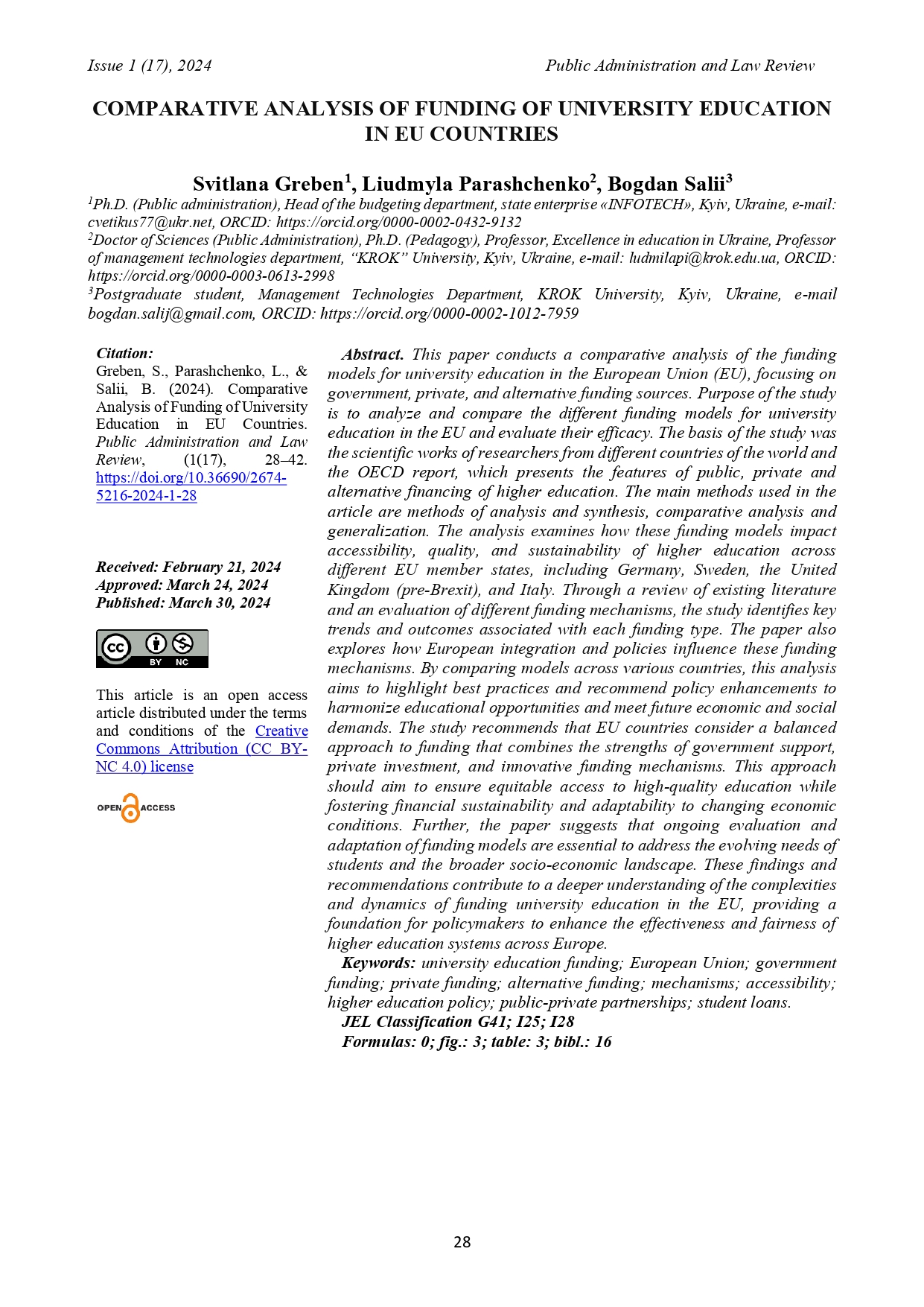COMPARATIVE ANALYSIS OF FUNDING OF UNIVERSITY EDUCATION IN EU COUNTRIES
DOI:
https://doi.org/10.36690/2674-5216-2024-1-28Keywords:
university education funding, European Union, government funding, private funding, alternative funding, mechanisms, accessibility, higher education policy, public-private partnerships, student loansAbstract
This paper conducts a comparative analysis of the funding models for university education in the European Union (EU), focusing on government, private, and alternative funding sources. Purpose of the study is to analyze and compare the different funding models for university education in the EU and evaluate their efficacy. The basis of the study was the scientific works of researchers from different countries of the world and the OECD report, which presents the features of public, private and alternative financing of higher education. The main methods used in the article are methods of analysis and synthesis, comparative analysis and generalization. The analysis examines how these funding models impact accessibility, quality, and sustainability of higher education across different EU member states, including Germany, Sweden, the United Kingdom (pre-Brexit), and Italy. Through a review of existing literature and an evaluation of different funding mechanisms, the study identifies key trends and outcomes associated with each funding type. The paper also explores how European integration and policies influence these funding mechanisms. By comparing models across various countries, this analysis aims to highlight best practices and recommend policy enhancements to harmonize educational opportunities and meet future economic and social demands. The study recommends that EU countries consider a balanced approach to funding that combines the strengths of government support, private investment, and innovative funding mechanisms. This approach should aim to ensure equitable access to high-quality education while fostering financial sustainability and adaptability to changing economic conditions. Further, the paper suggests that ongoing evaluation and adaptation of funding models are essential to address the evolving needs of students and the broader socio-economic landscape. These findings and recommendations contribute to a deeper understanding of the complexities and dynamics of funding university education in the EU, providing a foundation for policymakers to enhance the effectiveness and fairness of higher education systems across Europe.
Downloads
References
Cantwell, B., & Pusser, B. (2017). University fees and the commodification of university education. Higher Education Quarterly, 71(4), 409-427.
Clancy, P., & Dill, D. (2016). The research mission of the university. Policy Futures in Education, 14(7), 841-855.
Eurydice (2020). National education systems. European Commission.
Johnstone, D. B., & Marcucci, P. N. (2010). Financing higher education worldwide: Who pays? Who should pay? Johns Hopkins University Press.
Kaiser, F., Vossensteyn, H., & Koelman, J. (2015). Public funding of higher education: A comparative study. Routledge.
Marginson, S. (2018). Higher education and the common good. Melbourne University Publishing.
OECD (2021). Education at a Glance 2021: OECD Indicators. OECD Publishing.
Palacios, M. (2014). Investing in human capital: A capital markets approach to student funding. Cambridge University Press.
Salmi, J., & Hauptman, A. M. (2006). Innovations in tertiary education financing: A comparative evaluation of allocation mechanisms. Education Working Paper No. 6, World Bank.
Vossensteyn, H., et al. (2015). Global perspectives on higher education funding: A comparative study. International Journal of Educational Development, 40, 175-187.
S. Hreben, I. Mihus, L. Parashchenko, S. Laptіev, & V. Alkema. (2021). THE MECHANISM OF FINANCIAL CONTROL OVER THE ALLOCATION OF BUDGETARY FUNDS DEPENDING ON THE RESULTS OF SCIENTIFIC ACTIVITY OF A HIGHER EDUCATION INSTITUTION. Financial and Credit Activity Problems of Theory and Practice, 4(31), 466–476. https://doi.org/10.18371/fcaptp.v4i31.190998
Finikov, T. (2002). Suchasna vyshcha osvita: svitovi tendentsii ta Ukraina [Modern higher education: world trends and Ukraine]. Kyiv: Takson [in Ukrainian].
Parashchenko, L. I., & Shaporenko, O. I. (2018). Mekhanizmy derzhavnoho rehuliuvannia finansovo-ekonomichnoi diialnosti vyshchykh navchalnykh zakladiv [Mechanisms of state regulation of financial and economic activity of higher education institutions]. Vcheni zapysky Universytetu «KROK». Ekonomika —Academic notes of KROK University. Economy, 4 (52), 140—147 [in Ukrainian].
Hreben, S. (2018). Udoskonalennia mekhanizmu finansovoho kontroliu za rozpodilom biudzhetnykh mists v zalezhnosti vid naukovykh rezultativ diialnosti ZVO [Improvement of the mechanism of financial control over the allocation of budgetary places depending on the scientific results of the ZVO]. Vcheni zapysky Universytetu «KOOK». Ekonomika — Scientific notes of KROK University. Economy, 4 (52), 103—109 [in Ukrainian]
Salii, B. (2022). USING EXTENDED REALITY TECHNOLOGY IN EDUCATION. Economics, Finance and Management Review, (2), 85–94. https://doi.org/10.36690/2674-5208-2022-2-85.
Mihus, I. (2023). OVERVIEW OF THE METHODOLOGY OF UNIVERSITIES` INTERNATIONAL RANKINGS FOR MEETING THE CHALLENGES OF OPEN SCIENCE. Pedagogy and Education Management Review, (1), 13–21. https://doi.org/10.36690/2733-2039-2023-1-13

Downloads
Published
How to Cite
Issue
Section
License

This work is licensed under a Creative Commons Attribution-NoDerivatives 4.0 International License.





